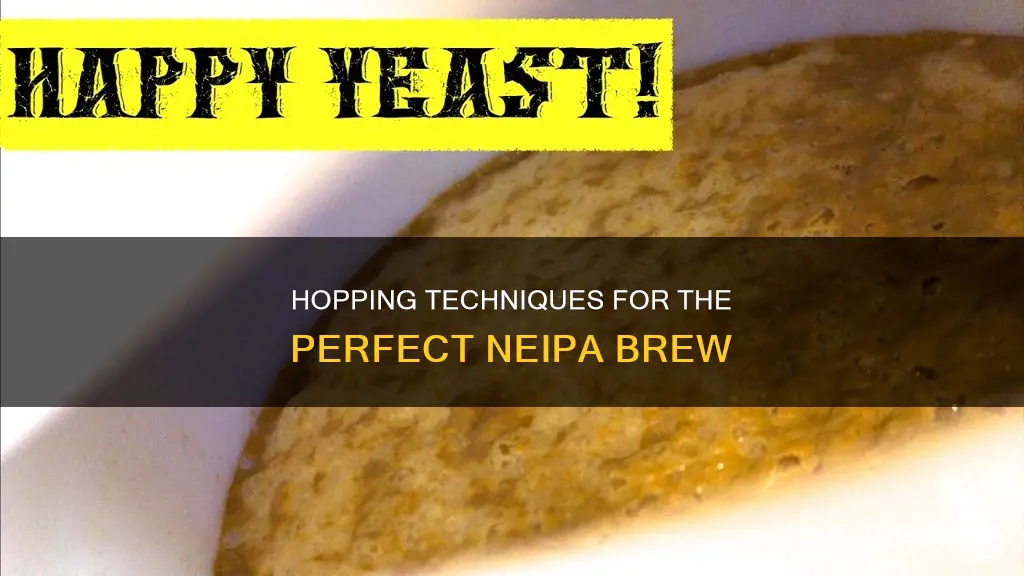
Brewing a New England IPA (NEIPA) is a challenging task, but with the right techniques and ingredients, it is possible to create a high-quality beer at home. NEIPAs are known for their intense fruit flavors, soft body, smooth mouthfeel, and hazy appearance. The key to success lies in late hop additions, dry hopping, water chemistry, yeast selection, and fermentation practices.
When brewing a NEIPA, it is essential to use a significant amount of late hop additions, especially during the whirlpool and dry hopping stages. Citra, Mosaic, Galaxy, and Amarillo are popular hop varieties for this style, known for their tropical and citrus characteristics. The right water chemistry is crucial, with a target chloride to sulfate ratio between 1:1 and 3:1, which contributes to the soft and pillowy mouthfeel.
Yeast selection is another critical factor. London Ale III (Wyeast 1318) and Dry English Ale (White Labs WLP007) are commonly used strains, known for their medium-to-low flocculation and high ester production, enhancing the fruity notes. Fermentation practices, such as dry hopping during active fermentation, can also impact the final product. Some brewers choose to harvest yeast before dry hopping to ensure yeast health and minimize oxidation.
Overall, brewing a NEIPA requires a delicate balance of ingredients, techniques, and attention to detail. With the right approach and experimentation, homebrewers can create delicious and hazy NEIPAs that rival those from commercial breweries.
| Characteristics | Values |
|---|---|
| Water profile targets | 175-200 ppm chloride, 75-100 ppm sulfate, and <150 ppm calcium |
| First wort hop addition | 5-8 IBUs |
| Hop additions | In the whirlpool, during fermentation, and post-fermentation |
| Dry hopping duration | 5-9 days |
| Total hop loads | 10 lbs./bbl (5 oz. per gallon/37 grams per L) |
| Hops | Citra®, Mosaic®, El Dorado®, Galaxy, Simcoe, Amarillo, Azacca, Idaho 7, Sabro, Strata, Motueka |
| Yeast | London Ale III, Wyeast 1318, Imperial Yeast Juice – A38, Omega British Ale V – OYL-011, Wyeast British Ale – 1098, White Labs Dry English Ale – WLP007, White Labs Saccharomyces “Bruxellensis” Trois – WLP644, Omega’s Tropical IPA – OYL200, Imperial Yeast Dry Hop – A24, SalAle US-05 and US-04, Wyeast London Ale III – 1318/A38 Juice |
| Fermentation temperature | 66–69 °F (19–21 °C) |
What You'll Learn

Water Chemistry: Chloride-to-Sulfate Ratios
Water chemistry is a complex topic and getting it right is critical for producing the best hazy New England IPAs. The mineral composition of brewing water can affect various facets of beer, from mash conversion and attenuation to flavour and mouthfeel.
The most common way brewers approach water chemistry is by focusing on the ratio of sulfate to chloride (SO4:Cl), which are added in the forms of gypsum (calcium sulfate) and calcium chloride, respectively. Sulfate is known to accentuate dryness and hop punchiness and has traditionally been favoured by IPA brewers, with common ratios ranging from 3:1 up to 7:1. However, NEIPA brewers often prefer the opposite, with ratios of around 1:3, as higher amounts of chloride are associated with perceived fullness, round malt flavour, and a softer hop character.
The ideal mineral content in brewing water can be difficult to achieve, as it differs from area to area. However, it is possible to add the desired ions directly to the water before the brewing process. For NEIPAs, the recommended ratio of chloride to sulfate is 3:1 or 2:1, with ideal mineral content as follows:
- 100-120ppm calcium
- 200ppm chloride
- 35ppm sodium
- 70ppm sulfate
NEIPAs require a fairly strict water composition, favouring softer water. Starting with RO water is recommended as it provides a clean slate and makes it easy to add the necessary ions and minerals.
Hops in Beer: Necessary or Overrated?
You may want to see also

Yeast Selection: Lower Flocculation for Haze Stability
Yeast selection is a critical aspect of brewing a hazy New England IPA (NEIPA). The chosen yeast strain will influence the flavour, aroma, attenuation, and flocculation – all of which contribute to the haze stability of the final beer.
Flocculation refers to the yeast's tendency to clump together and drop out of suspension, settling at the bottom of the fermenter. While high-flocculation yeasts produce clear beers, lower flocculation is desirable for NEIPAs to maintain haze stability.
London Ale III (also known as WY1318) is a popular yeast strain for NEIPAs due to its low flocculation characteristics and flavour profile. It produces tropical notes that complement the flavours and aromas typically derived from IPA hops. This yeast strain also contributes to the haze stability of the beer, as the majority of the haze it creates does not drop out, even after weeks in the keg.
Fermentation temperatures play a crucial role in optimising yeast activity and flavour production. For London Ale III, a temperature range of 64–74°F (18–23 °C) is recommended, with the best results achieved by starting at the lower end and gradually increasing the temperature.
Another factor to consider is the amount of yeast pitched. Underpitching can be beneficial as the added stress promotes ester development, resulting in delicate stone fruit esters that complement the citrus and tropical fruit character of the hops. However, it is important to maintain a clean and healthy fermentation to ensure proper attenuation and avoid any phenolics.
In addition to London Ale III, other yeast strains commonly used in NEIPAs include Conan, Imperial Juice (A38), White Labs London Fog Ale (WLP066), and Omega British Ale V (OYL-011). These strains offer varying levels of bioconversion, clarity, and reliability, allowing brewers to achieve the desired characteristics in their beers.
By selecting yeast strains with lower flocculation characteristics and carefully controlling fermentation conditions, brewers can enhance haze stability in their NEIPAs, contributing to the desired hazy appearance and overall sensory experience of the beer.
Micolob Beer's Hoppy Secret: What's Inside?
You may want to see also

Hop Selection: Tropical Citrusy Hops
When it comes to hop selection for a NEIPA, it's important to choose hops that will complement the tropical notes driven by the yeast. Tropical citrusy hops that are fruit-forward are a good choice, such as Citra, Mosaic, and Galaxy. These hops will give you a lot of tropical flavors like mango, passionfruit, guava, and pineapple. You can also use newer experimental varieties or hops with stone fruit or citrus qualities, like Amarillo or El Dorado.
It's best to start with just a few hop varieties, rather than combining too many at once, which can result in a muddled mess of flavors. You can also look for hops with high levels of polyphenols, which can contribute to a more permanent haze in your beer.
In addition to hop selection, the timing and temperature of your hop additions are crucial. Most of your hot-side hops should be added during the whirlpool, with temperatures ranging from 108°F to 185°F, depending on your preference. You can also experiment with dry hopping during active fermentation, which is believed to enhance the flavors and aromas of the finished product through chemical reactions between the yeast and hops. This technique is known as biotransformation and can lead to juicier and more pronounced tropical flavors.
Overall, the key to a successful NEIPA is to focus on the hops that will bring out the tropical citrusy flavors you're looking for and to carefully consider the timing and temperature of your hop additions to maximize the flavor and aroma of your beer.
The Essential Ingredient in Beer: Hops or Not?
You may want to see also

Dry Hopping: Active Fermentation for Biotransformation
Dry hopping is a key process in brewing New England IPAs (NEIPAs) and involves adding hops during fermentation. This technique is believed to enhance the perception of juicy hop character in the beer by encouraging a chemical process known as biotransformation.
Biotransformation is the process by which a substance changes from one compound to another through chemical reactions. In the context of brewing, it refers to the transformation of certain terpenoids in hops when they interact with specific yeast strains during active fermentation. This process is thought to result in the creation of other terpenoids with more desirable flavours and aromas.
The most commonly discussed example of biotransformation in brewing involves the transformation of geraniol, a floral-scented compound, into citronellol, which has a sweet, rose-like, citrusy fragrance. This transformation is believed to contribute to the "juicy" character that NEIPAs are known for.
By dry hopping during active fermentation, brewers can also take advantage of the yeast's ability to metabolise any oxygen that is inevitably introduced when adding hops to the beer. This helps to minimise oxidation and keep the NEIPA fresher for longer.
When to add the hops during fermentation depends on the desired flavour profile and other processes in the brewing schedule. Some brewers choose to add hops early in the fermentation process, during high kräusen, to encourage biotransformation. Others opt to add hops later in the fermentation process or even after it is complete to avoid the potential grassy or vegetal flavours that can come from extended dry hopping.
Some brewers also choose to add multiple dry hop charges at different stages of fermentation to get the best of both worlds. This technique is known as double dry hopping (DDH) and can result in more intense hop flavours and aromas.
In terms of contact time, research suggests that most of the oil extraction from dry hopping occurs within the first day. Leaving the hops in contact with the beer for longer periods may even lead to a slight decrease in oil extraction. Therefore, it is generally recommended to dry hop for no more than a few days.
Overall, dry hopping during active fermentation for biotransformation is a valuable technique for brewing NEIPAs, as it can enhance the perception of juicy hop character, minimise oxidation, and contribute to the unique flavour and aroma profile of this popular beer style.
Hops and Cannabis: THC in Beer Explored
You may want to see also

Whirlpool Hops: Low-IBU First Wort Hop Addition
Whirlpool hops are an important part of brewing a New England-style IPA (NEIPA). While the style is known for its low bitterness, whirlpool hops can help to build a baseline bitterness that complements the other flavours in the beer.
For a NEIPA, a small first wort hop addition of around 5-8 IBUs is recommended. This provides a softer baseline bitterness that can be built upon with other hop additions. This technique also helps to prevent boil-overs in the kettle.
For the remaining hop additions, a staggered approach is often used. This involves making multiple whirlpool additions over 20-30 minutes, allowing for more complexity and unique expressions from the hops. For homebrewers, a simpler approach can be taken by making a larger flameout addition or using a hop stand.
When selecting hops for a NEIPA, it is important to choose varieties that will contribute to the desired fruit-forward and tropical flavours. Citra®, Mosaic®, Galaxy, Simcoe, Amarillo, El Dorado, and experimental varieties are commonly used in NEIPAs.
In terms of quantity, a typical whirlpool addition for a NEIPA could be around 3-5 ounces per 5.5-gallon batch. This will provide a solid backbone for the dry hopping, which is where the majority of the juicy flavour and aroma come from.
Overall, finding the perfect balance between hop flavour, aroma, and bitterness is key to brewing a successful NEIPA. Diversifying the whirlpool schedule and experimenting with different hop varieties and quantities can help to achieve the desired results.
Belgian Beer and Hops: A Complex Relationship
You may want to see also
Frequently asked questions
The ideal water profile for a NEIPA is a chloride to sulfate ratio of between 1:1 and 3:1, which is the near inverse of what you would use in a West Coast IPA. This means that the ppm of chloride is higher than the ppm of sulfate. For example, a target ratio of 2:1 would be 200ppm chloride and 100ppm sulfate.
The best yeast for a NEIPA is a medium-to-low attenuating, medium-to-low flocculating, high-ester-producing strain. The most popular strains are London Ale III (Wyeast 1318) and Dry English Ale (White Labs WLP007).
The best dry-hopping technique for a NEIPA is to dry hop during active fermentation. This will help to keep the hop matter in suspension and extract as much flavour as possible from the hops. It will also help to minimise oxidation, keeping the beer fresh for longer.







